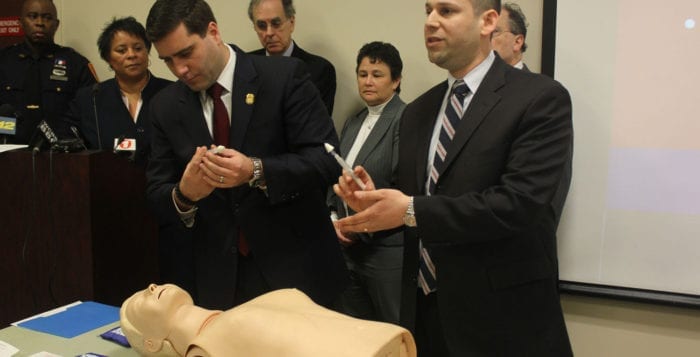The Comsewogue girls’ basketball team dropped its second-to-last game of the season to Sayville Feb. 7, 51-44, on senior night, but it wasn’t for a lack of effort from the Warriors.

“I think we came out really strong, got them a little nervous — on their heels a little bit,” senior Sam Collins said.
That’s because she was swishing shot after shot from beyond the arc. Collins scored all nine of her team’s first-quarter points on 3-pointers, and added another at the start of the second.
“I work so hard on it and when I get an open shot I’m happy to take it,” she said. “It helps my teammates and it’s hard to contest a shot like that.”
Her coach likes what he’s seen from his four-year starter as well. Collins has racked up 43 3-pointers this season.
“She makes a living out there,” Comsewogue head coach Joe Caltagirone said. “She can post up too, but with the 1-3-1 defense that [Sayville plays] it was suited for her to stay out on the wing and take the open shots when she had them.”
The game, which was Comsewogue’s first home loss of the season, was tight through most of the first half. Collins’ fourth trey countered a Sayville 3-pointer, and junior Nora Gabel scored a field goal that put her team out front 14-11, but Sayville always had an answer, or two, and by the end of the first half Sayville had a 24-18 advantage.
Sayville’s defense intercepted multiple passes and won its fair share of battles on the boards, but junior Hannah Dorney grabbed multiple rebounds for Comsewogue, and forced a few turnovers herself.

“We softened their defense, we broke it down pretty good and got some good looks, but our shots didn’t fall,” Caltagirone said. “Hannah has been a great addition off the lacrosse team. We had to play their style with the aggressiveness and working baseline to baseline, which she helped with. I was pleased with their effort.”
Heading into the halftime break, Collins said her team talked about ways to make sure the game didn’t slip away.
“We wanted to move the ball a lot more to make them move because they’re eventually going to get tired,” she said. “If we take the first available shot, it’s easy for them to play defense, but if we wait the whole shot clock and get the best shot possible, they can’t do anything about it.”
At first, it worked. Senior Megan Turner drew a foul and sank both of her free throws, Gabel added a 3-pointer and Dorney scored a field goal to regain the lead for Comsewogue, 25-24. Despite the team’s best efforts, Sayville always had a response. Gabel and junior Georgia Alexiou added four points each in the third, but the Warriors fell behind 45-41. and that was the closest they would get.
“As the game progressed we lost it a little bit, then we came back, but there wasn’t enough time on the clock,” Collins said. “We communicate well, we didn’t give them easy baskets, we made them work for it, and we moved the ball.”

Caltagirone honored Collins, Turner, Brittany DeLeva, Lauren Gray and Christiany Pizarro before the game as part of the senior night festivities.
“It’s bittersweet — I’ll miss them,” the head coach said. “Some are three- and four-year players I’ve been coaching for a while and they mean a lot to the program. I’m happy for them, but I’m sad to lose them.”
Collins was also emotional.
“I never thought this day would come,” she said. “I wish we could’ve gotten the win, but I know we played our best, and that’s enough for me.”
She said despite the loss the energy is high heading into the postseason, and Caltagirone said he believes in the squad’s ability, noting how this season compared to last. The Warriors are winning the close games and aren’t letting teams back into games, something he said is big for the team.
“They do the hard work,” he said. “I’m pretty confident that we can play with anybody. We’ve shown we can play with anybody.”






 To help give back to the community, Coach Realtors of Stony Brook and Port Jefferson will hold its 4th annual food drive during the month of February for the benefit of the Infant Jesus Food Pantry, Open Cupboard, in Port Jefferson. “Unfortunately during the winter months, the local food pantries are in desperate need of supplies,” said food drive organizer and realtor Debbie Battaglia.
To help give back to the community, Coach Realtors of Stony Brook and Port Jefferson will hold its 4th annual food drive during the month of February for the benefit of the Infant Jesus Food Pantry, Open Cupboard, in Port Jefferson. “Unfortunately during the winter months, the local food pantries are in desperate need of supplies,” said food drive organizer and realtor Debbie Battaglia.






 Jason Whiffen of Port Jefferson captured this image of Porf Jefferson Harbor on Jan. 8 after a winter storm using his iPhone.
Jason Whiffen of Port Jefferson captured this image of Porf Jefferson Harbor on Jan. 8 after a winter storm using his iPhone.




